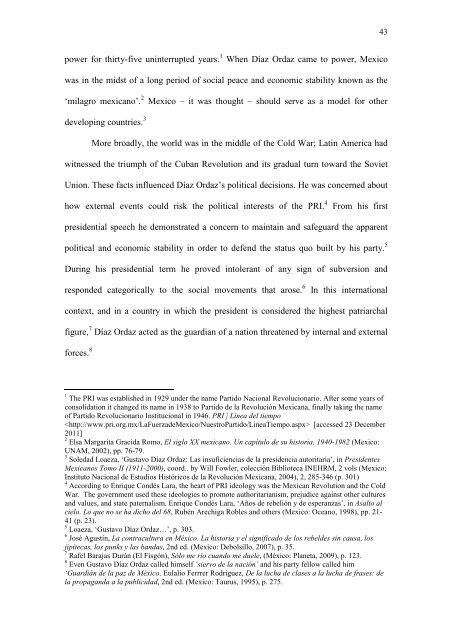Leticia Neria PhD thesis - Research@StAndrews:FullText ...
Leticia Neria PhD thesis - Research@StAndrews:FullText ...
Leticia Neria PhD thesis - Research@StAndrews:FullText ...
You also want an ePaper? Increase the reach of your titles
YUMPU automatically turns print PDFs into web optimized ePapers that Google loves.
power for thirty-five uninterrupted years. 1 When Díaz Ordaz came to power, Mexico<br />
was in the midst of a long period of social peace and economic stability known as the<br />
‘milagro mexicano’. 2 Mexico – it was thought – should serve as a model for other<br />
developing countries. 3<br />
More broadly, the world was in the middle of the Cold War; Latin America had<br />
witnessed the triumph of the Cuban Revolution and its gradual turn toward the Soviet<br />
Union. These facts influenced Díaz Ordaz’s political decisions. He was concerned about<br />
how external events could risk the political interests of the PRI. 4 From his first<br />
presidential speech he demonstrated a concern to maintain and safeguard the apparent<br />
political and economic stability in order to defend the status quo built by his party. 5<br />
During his presidential term he proved intolerant of any sign of subversion and<br />
responded categorically to the social movements that arose. 6 In this international<br />
context, and in a country in which the president is considered the highest patriarchal<br />
figure, 7 Díaz Ordaz acted as the guardian of a nation threatened by internal and external<br />
forces. 8<br />
1<br />
The PRI was established in 1929 under the name Partido Nacional Revolucionario. After some years of<br />
consolidation it changed its name in 1938 to Partido de la Revolución Mexicana, finally taking the name<br />
of Partido Revolucionario Institucional in 1946. PRI | Línea del tiempo<br />
[accessed 23 December<br />
2011]<br />
2<br />
Elsa Margarita Gracida Romo, El siglo XX mexicano. Un capítulo de su historia, 1940-1982 (Mexico:<br />
UNAM, 2002), pp. 76-79.<br />
3<br />
Soledad Loaeza, ‘Gustavo Díaz Ordaz: Las insuficiencias de la presidencia autoritaria’, in Presidentes<br />
Mexicanos Tomo II (1911-2000), coord.. by Will Fowler, colección Biblioteca INEHRM, 2 vols (Mexico:<br />
Instituto Nacional de Estudios Históricos de la Revolución Mexicana, 2004), 2, 285-346 (p. 301)<br />
4<br />
According to Enrique Condés Lara, the heart of PRI ideology was the Mexican Revolution and the Cold<br />
War. The government used these ideologies to promote authoritarianism, prejudice against other cultures<br />
and values, and state paternalism. Enrique Condés Lara, ‘Años de rebelión y de esperanzas’, in Asalto al<br />
cielo. Lo que no se ha dicho del 68, Rubén Arechiga Robles and others (Mexico: Oceano, 1998), pp. 21-<br />
41 (p. 23).<br />
5<br />
Loaeza, ‘Gustavo Díaz Ordaz…’, p. 303.<br />
6<br />
José Agustín, La contracultura en México. La historia y el significado de los rebeldes sin causa, los<br />
jipitecas, los punks y las bandas, 2nd ed. (Mexico: Debolsillo, 2007), p. 35.<br />
7<br />
Rafel Barajas Durán (El Fisgón), Sólo me río cuando me duele, (México: Planeta, 2009), p. 123.<br />
8<br />
Even Gustavo Díaz Ordaz called himself ‘siervo de la nación’ and his party fellow called him<br />
‘Guardián de la paz de México. Eulalio Ferrrer Rodríguez, De la lucha de clases a la lucha de frases: de<br />
la propaganda a la publicidad, 2nd ed. (Mexico: Taurus, 1995), p. 275.<br />
43

















